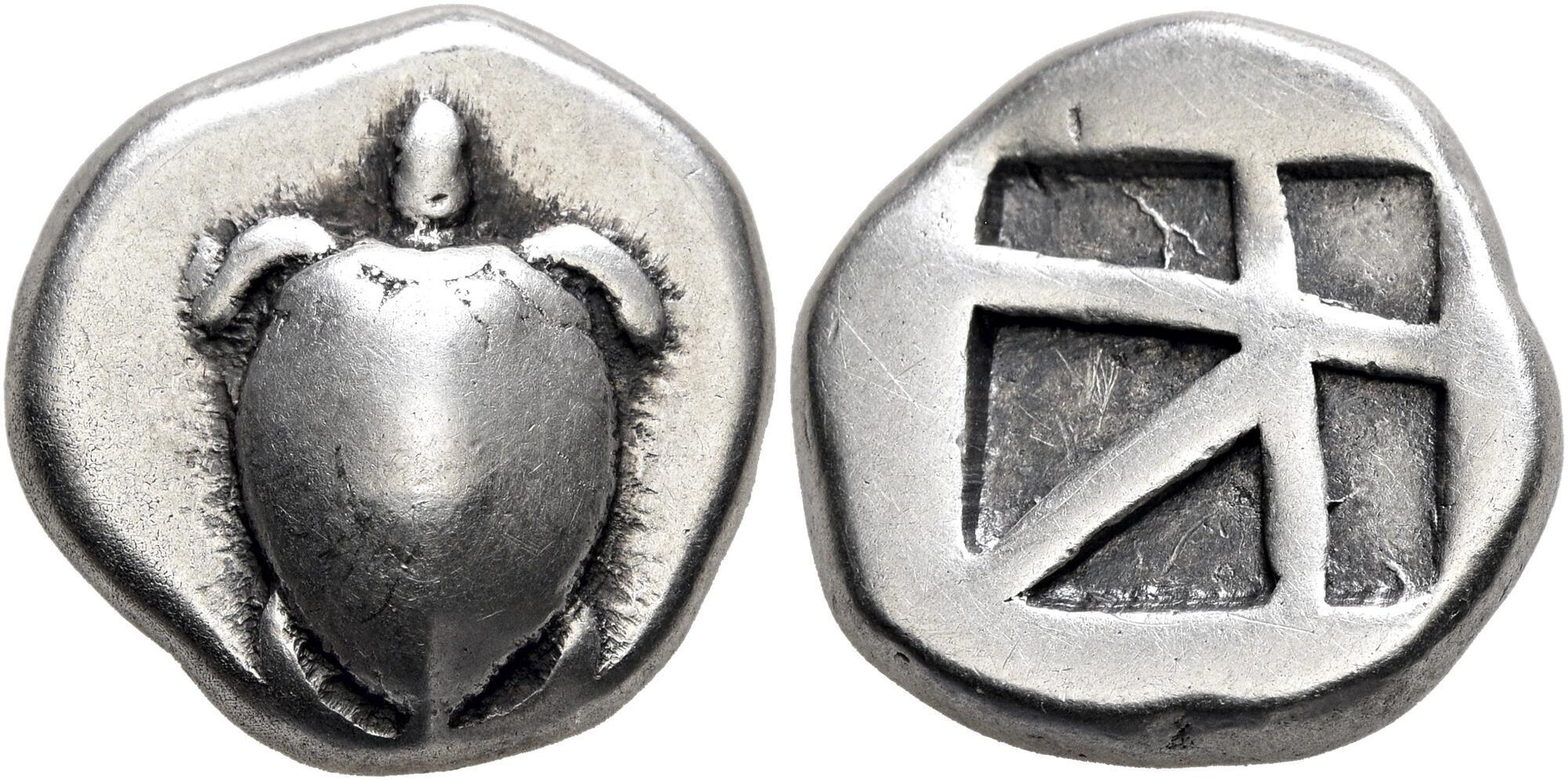22378 - Citium (Azbaal) (double siglos Heracles/lion & stag) over Aegina (turtle/incuse square) (Roma Numismatics, EA 61, Aug. 2019, 339)
From SILVER
449 BCE - 425 BCE
Location/history
| Sale(s)Sale(s) ᵖ: | Roma Numismatics, EA 44, 3 March 2018, 354 = Roma Numismatics, EA 61, 22 Aug. 2019, 339 | |
| Private collection(s)Private collection(s) ᵖ: | From the inventory of a German dealer. |
Overstriking coin
Description
| ObverseInscription or printing placed on the obverse.: | Herakles, wearing lion skin, in fighting stance right, holding club and bow | ReverseInscription or printing placed on the reverse.: | Lion attacking stag crouching right in dotted square within incuse square |
Mint and issuing power
| MintIdentifies the place of manufacture or issue of a numismatic object.: | Citium | Ancient regionAncient region. | Cyprus | Modern countryModern country: Greece | AuthorityIdentifies the issuing power. The authority can be "pretended" when the name or the portrait of X is on the coin but he/she was not the issuing power. It can also be "uncertain" when there is no mention of X on the coin but he/she was the issuing power according to the historical sources: | Azbaal of Citium (Phoenician king of Citium and Idalium, 5th c BC) |
Chronology
| FromIdentifies the initial date in a range assigned in a numismatic context. 449 BCE toIdentifies the final date in a range assigned in a numismatic context.. 425 BCE | Classical 480-323 BC |
Physical description
| MetalThe physical material (usually metal) from which an object is made.: Silver |
WeightWeight of the numismatic object (in grams). in grams: 11.0311.03 g <br />11,030 mg <br /> | DenominationTerm indicating the value of a numismatic object. Examples: tetradrachm, chalkous, denarius.: double siglos |
AxisDescribes the directional relationship between the obverse and reverse of a numismatic object.: 1010 mm <br />1 cm <br /> |
| DiameterDescribes diameter of an object (in mm).: 2323 mm <br />2.3 cm <br /> | StandardStandard.: Persian | ||
References
| Coin referenceReference of the Coin: | Coin series referenceReference to coin series study: | BMC Crete1BMC Crete, p. 10-11, n° 16-18, pl. III, n° 1-4, Tziambazis 20022Tziambazis 2002, n° 17, Zapiti - Michaelidou 20083Zapiti - Michaelidou 2008, n° 5 | |
| Coin series web referenceCoin series web references: | |||
Overstruck type
Description
| ObverseInscription or printing placed on the obverse.: | Turtle | ReverseInscription or printing placed on the reverse.: | Union Jack incuse square |
Mint and issuing power
| MintIdentifies the place of manufacture or issue of a numismatic object. ᵖ: | Aegina | Ancient regionAncient region. ᵖ | Attica | Modern countryModern country: Greece | AuthorityIdentifies the authority in whose name (explicitly or implicitly) a numismatic object was issued. ᵖ: |
Chronology
| FromIdentifies the initial date in a range assigned in a numismatic context. 480 BCE toIdentifies the final date in a range assigned in a numismatic context.. 457 BCE | Classical 480-323 BC |
Physical description
| DenominationTerm indicating the value of a numismatic object. Examples: tetradrachm, chalkous, denarius. ᵖ: | stater |
StandardStandard. ᵖ: | Aeginetic |
References
| Coin type referenceReference to coin series study ᵖ: | HGC 64HGC 6, n° 437, Meadows (forthcoming)5Meadows (forthcoming), Groups IIa-IIb | ||
| Coin series web reference overstruckCoin series web references overstruck: | |||
Additional data
| Frequency of overstrikesFrequency of overstrikes: | frequent | Level of confidenceLevel of confidence of the identification: | sure |
| RemarksRemarks: | Overstruck on a stater of Aegina | ||
References
- ^ Wroth, Warwick William (1886), A Catalogue of the Greek coins in the British Museum. vol. X : Crete and the Aegean Islands, London, The Trustees, p. 152, pl. XXIX
- ^ Tziambazis, Elias (2002), A catalogue of the coins of Cyprus: from 560 B.C. to 1571 A.D., Larnaca, 89 p.
- ^ Zapiti, Eleni - Michaelidou, Lefki (2008), Coins of Cyprus : from the collection of the Bank of Cyprus Cultural Foundation, Nicosia, Bank of Cyprus Cultural Foundation, 329 p.
- ^ Hoover, Oliver D. (2010), The Handbook of Greek Coinage Series, volume 6 : handbook of coins of the islands: Adriatic, Iionian, Thracian, Aegean, and Carpathian seas (excluding Crete and Cyprus), sixth to first centuries BC, Lancaster, 358 p.
- ^ Meadows, Andrew (forthcoming), Greek coinage in the Persian Empire: The Malayer 1934 Hoard (IGCH 1790).

